How to Clean Cast Iron Griddle on Gas Stove – Astonishing Hack!
Introduction
Cleaning a cast iron griddle on a gas stove can feel like a chore, but it’s easier than you think. I’ve been cooking on cast iron for years, and I’ve learned a few tricks to keep it spotless without ruining the seasoning. The key is knowing what to use—and what to avoid. Harsh soap? Big no. A little salt and warm water? Perfect. If you’ve ever wondered how to clean a cast iron griddle on a gas stove the right way, I’ve got you covered. Let’s break it down so your griddle stays non-stick and rust-free for years!
Understanding Cast Iron Griddles on Gas Stoves
A cast iron griddle on a gas stove is a must-have for home cooks. It heats evenly, holds heat well, and gives food a perfect sear. Whether you’re making pancakes or grilling steaks, it’s a kitchen workhorse. But cast iron needs care. If you don’t clean and season it right, it can get sticky or rusty. The good news? It’s easy to maintain. Once you learn the basics, you’ll never go back.
Why Use a Cast Iron Griddle on a Gas Stove?
Cast iron is strong, reliable, and built to last. Unlike other cookware, it spreads heat evenly. No more hot spots that burn food! It’s great for everything—crispy bacon, fluffy pancakes, grilled cheese. With the right care, a cast iron griddle can last a lifetime. But to keep it in top shape, you need to clean it the right way.
Common Problems with Cast Iron Griddles
Cast iron isn’t hard to use, but it does have quirks. Have you ever cooked on a sticky surface? That’s a sign the seasoning is wearing off. If you leave it wet, rust forms fast. Burnt-on food is another problem. Scrubbing too hard can ruin the seasoning. But don’t worry—these issues are easy to fix. A well-maintained griddle should be smooth, non-stick, and ready for anything.
The Importance of Regular Cleaning & Seasoning
Think of seasoning like a protective shield. It creates a natural non-stick layer, making cooking easier. Every time you cook with oil, you strengthen it. But harsh scrubbing can strip it away. Cleaning is just as important. Too much soap? You’ll remove the seasoning. Too little? Grease builds up. The key is balance—gentle scrubbing and regular oiling.
Taking care of your cast iron griddle isn’t just about cleaning—it’s about better cooking. Now that you know why it matters, let’s dive into how to clean it the right way!
How to Clean a Gas Stove’s Cast Iron Griddle
Cleaning a cast iron griddle might seem tricky, but trust me—it’s easier than you think. If you’ve ever struggled with stuck-on food, rust, or grease buildup, you’re not alone. I’ve been cooking on cast iron for years, and through trial and error, I’ve learned the best way to clean it without ruining the seasoning.
Step 1: Gather Your Cleaning Supplies

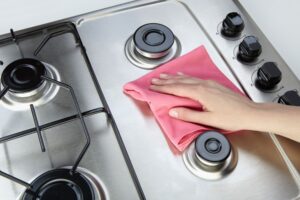
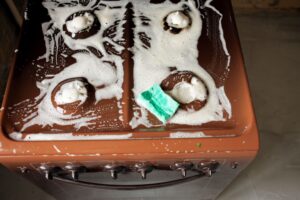
Ascertain that you have all you require before we begin. You don’t need fancy cleaners—just a few basic items:
- Soft sponge or brush (avoid steel wool—it’s too harsh)
- Warm water
- Mild dish soap (optional, only for deep cleaning)
- Kosher salt (for scrubbing)
- White vinegar (for rust removal)
- Paper towels or a lint-free cloth
- Cooking oil (for re-seasoning)
Step 2: Cleaning Process (Step-by-Step Guide)
Here’s how to clean your griddle properly while keeping the seasoning intact:
Cool the Griddle Completely
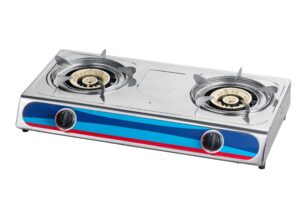
Never clean a hot griddle! It can warp as a result of abrupt temperature fluctuations. Before you begin cleaning, let it cool.
Remove Loose Debris
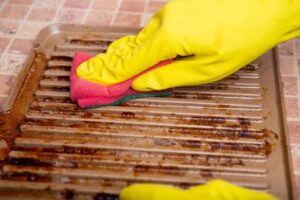
Use a dry paper towel or a brush to wipe off crumbs, grease, or food bits. This makes the next steps easier.
Scrub with Warm Water & Salt
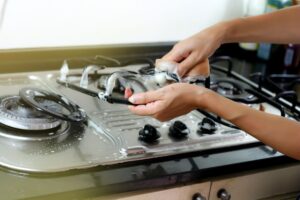
For everyday cleaning, sprinkle kosher salt on the griddle. Then, use a damp cloth or brush to scrub gently. Salt acts as a natural abrasive without stripping the seasoning.
Use Vinegar for Stubborn Stains or Rust
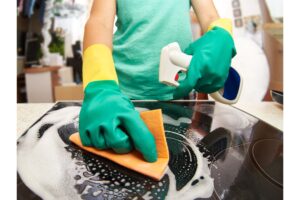
If your griddle has rust or tough stains, mix equal parts white vinegar and water. Soak the affected area for a few minutes, then scrub with a brush. Rinse quickly—don’t let it sit too long, or it may damage the seasoning.
Rinse and Dry Immediately
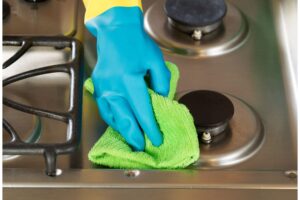
Never leave your cast iron wet! Rinse it under warm water, then dry it completely with a towel. Rust can result from any residual moisture.
Re-season to Restore Non-Stick Surface

Once the griddle is clean and dry, apply a thin layer of oil (flaxseed, canola, or vegetable oil works best). Heat it on the stove until it starts to smoke slightly. This step helps rebuild the seasoning, keeping your griddle slick and non-stick.
Quick Cleaning Tips
- Avoid soaking cast iron—it absorbs water and rusts quickly.
- Skip the dishwasher—harsh detergents ruin the seasoning.
- Don’t use too much soap—it can strip away the protective layer.
- Re-season regularly—the more you use it, the better it gets!
Now that you know how to clean your cast iron griddle on a gas stove the right way, you’ll enjoy cooking without the hassle of stuck-on food or rust. A little care goes a long way, and soon, cleaning will feel like second nature. Happy cooking!
How to Clean a Cast Iron Griddle with Burnt-On Food
We’ve all been there—you finish cooking, only to find stubborn burnt-on food stuck to your cast iron griddle. Scrubbing endlessly doesn’t work, and you’re worried about ruining the seasoning. Don’t stress! I’ve tackled this problem more times than I can count, and I’ve got the best tricks to get your griddle clean without damaging it.
Use the Boiling Water Trick
One of the easiest ways to loosen burnt-on food is with boiling water. Here’s how:
- Place the griddle back on the gas stove and add a small amount of water—just enough to cover the stuck food.
- Turn on the heat and let the water simmer for a few minutes.
- Use a wooden spatula to gently scrape off the softened bits.
- Once clean, dry immediately and apply a thin layer of oil.
Quick Answer: Boiling water helps loosen stuck-on food without harsh scrubbing, protecting your seasoning.
Make a Baking Soda Paste
Baking soda is a gentle yet effective cleaner that won’t strip your seasoning. Here’s what to do:
- To make a paste, use equal parts water and baking soda.
- After applying the paste to the burned regions, wait ten minutes.
- Use a gentle brush or towel to scrub softly.
- Rinse well, dry immediately, and re-season.
Quick Answer: Baking soda paste lifts burnt food while keeping your griddle’s seasoning intact.
Try the Salt Scrub Method
If the burnt-on food is mild, kosher salt can do the trick. It is mild on the seasoning yet enough abrasive to remove residue.
- Over the burned areas, liberally sprinkle salt.
- Scrub in circular motions with a paper towel or moist cloth.
- Rinse with warm water after removing the salt.
- After thoroughly drying, lightly coat with oil.
Quick Answer: Kosher salt acts as a natural scrubber that removes burnt bits without harming the seasoning.
When Is It Okay to Use Soap?
You’ve probably heard the old rule: “Never use soap on cast iron.” But sometimes, a tiny bit of mild dish soap is okay—especially for heavy grease or extreme burnt-on food. Just be sure to:
- Use a small amount.
- Rinse quickly.
- Re-season after cleaning.
Quick Answer: A little soap won’t ruin your cast iron, but always re-season after using it.
Final Thoughts
Burnt-on food doesn’t have to be a nightmare. Whether you use boiling water, baking soda, or salt, you can get your griddle clean without losing that precious seasoning. And remember—prevention is key. You can avoid future deep cleaning sessions by cooking with adequate oil and cleaning your griddle immediately after use. Have fun in the kitchen!
How to Clean a Cast Iron Griddle That Has Rust
Rust on a cast iron griddle? No worries! It happens to everyone. Maybe you left it wet, stored it in a damp spot, or found an old one. Rust doesn’t mean it’s ruined. With a little effort, you can make it good as new. Let’s go step by step.
Quick Answer:
To clean a rusty cast iron griddle, scrub with salt and vinegar, use a wire brush for heavy rust, rinse well, dry fast, and season with oil.
Step 1: Check the Rust
Look at the rust. If it’s light, scrubbing will fix it. You’ll need a more robust approach if it’s heavy. Don’t worry—cast iron is strong, and rust is easy to fix.
Step 2: Scrub with Salt and Vinegar
For light rust, use kosher salt and vinegar:
- Sprinkle salt on the rusty spots.
- Pour a little white vinegar on top.
- Scrub with a brush or aluminum foil in circles.
- Keep scrubbing until the rust comes off.
- Rinse with warm water and dry right away.
Quick Tip: Salt and vinegar break down rust without harming the griddle.
Step 3: Use a Wire Brush for Heavy Rust
If rust won’t budge, try this:
- For cleaning, use steel wool or a wire brush.
- If needed, mix equal parts vinegar and water. Let it sit for 5–10 minutes.
- Scrub until you see bare metal.
- Rinse well and dry fast.
Quick Tip: A wire brush removes deep rust, but you’ll need to re-season.
Step 4: Rinse and Dry Fast
Rinse the griddle with warm water after the rust has been removed. To get rid of any moisture, pat it dry with a towel and place it on a hot stove for a few minutes.
Quick Tip: Drying fast stops rust from coming back.
Step 5: Re-season the Griddle
Now it’s time to season your griddle.
- Apply a thin coating of oil (vegetable, flaxseed, or canola) all over.
- On a gas stove, heat it until it begins to smoke.
- After turning off the heat, let it to cool.
- Repeat 2–3 times for best results.
Quick Tip: Seasoning protects the griddle and makes it non-stick.
Step 6: Stop Rust Before It Starts
Keep your griddle rust-free by:
- Drying it well after washing.
- Storing it in a dry place.
- Rubbing a little oil on it before storing.
- Keeping it away from humidity.
Quick Tip: Proper care keeps rust away for good.
Final Thoughts
Rust looks bad, but it’s easy to fix! Your cast iron griddle will survive for many years with proper cleaning, seasoning, and maintenance. Simply keep it seasoned, dry it thoroughly, and enjoy cooking without rust. Have fun on the grill!
How to Use a Gas Stove to Season a Cast Iron Griddle
Want your cast iron to work like magic? Let’s get it ready! A good coat of oil makes food slide right off. It stops rust too. I’ll show you how to do it right.
Why You Need to Season Your Griddle
Think of seasoning like giving your griddle a shield. It keeps food from getting stuck. It blocks rust. It makes your food taste better too! Skip this step, and you’ll have food that sticks and rust that forms fast. However, if you perform it correctly, your griddle will survive for many years.
Quick Tip: Good seasoning means no stick, no rust, and better food.
Step 1: Get What You Need
Here’s what to grab:
- Oil that won’t add taste (like canola or plain cooking oil)
- Clean paper towels
- Tongs to hold the towels
- Your gas stove
Quick Tip: You just need basic items from your kitchen!
Step 2: Clean It First
Start with a clean griddle. Wash off any dirt or rust with warm water and salt. Dry it well! Any wet spots can rust.
Quick Tip: Clean and dry is the way to start.
Step 3: Put On the Oil
Add just a tiny bit of oil. Spread it thin with a paper towel. You want it to look like there’s almost no oil there. Too much will make it sticky.
Quick Tip: Less oil works better than more!
Step 4: Heat It Up
Turn your stove to medium-high. Wait for the oil to smoke. This makes the oil stick to the metal. Keep the heat on for about 15 minutes. Then let it cool down.
Quick Tip: The smoke means it’s working!
Step 5: Do It Again
Want it even better? Do the oil and heat steps 2-3 more times. Each time makes it work better. As you use it more, it gets better!
Quick Tip: More layers make it work great.
Step 6: Let It Cool and Store It
Wait till it’s cool. Wipe off any extra oil. Keep it in a dry spot. Put a paper towel under it to keep water away.
Quick Tip: Keep it dry when you put it away.
When to Season Again
If you use it a lot, just add a tiny bit of oil after each use. If it looks dull or food sticks, do all the steps again.
Quick Tip: A quick oil wipe keeps it nice. Do the full steps when it needs help.
What Not to Do
Watch out for these big mistakes:
- Using too much oil makes it sticky
- Not cleaning it first ruins the coating
- Not heating it long enough won’t work right
- Putting it away wet causes rust
Quick Tip: Less oil, clean start, good heat, and dry storage work best.
Last Words
Taking care of your griddle pays off big! You’ll get great food that slides right off. Your pancakes will be perfect. Your bacon will be crisp. Your steaks will look great. Give your griddle some love, and it will cook great for years!
Quick Tip: A good griddle makes better food. Now go cook something tasty!
Remember: I use my griddle every day, and these tips come from years of cooking. Trust me, it’s worth doing right!
How to Maintain Your Cast Iron Griddle for Long-Term Use
Let me tell you about keeping your cast iron griddle in top shape! I’ve had mine for years, and I’ve learned what works best. It’s like taking care of a good friend – show it some love, and it’ll cook amazing food for you forever!
Quick Tip: Clean it right after use, dry it well, and add a thin coat of oil to keep your griddle perfect for years.
Keep It Clean, But Be Gentle After you cook, let the griddle cool down a bit. Wipe it with a dry paper towel first. If food sticks, use warm water and salt to scrub it off. Never soak it! I learned this the hard way when I left mine in water once – rust showed up the next day.
Quick Tip: A quick wipe after cooking stops food from getting stuck.
Oil Is Your Friend Each time you clean your griddle, put on a thin coat of oil. I use canola oil, but any cooking oil works fine. Just warm it up on low heat for a few minutes. This keeps rust away and makes the surface better for cooking.
Quick Tip: A light oil coat after each use makes your griddle more non-stick.
Store It Right Keep your griddle in a dry spot. I put a paper towel under mine to catch any oil drops. Never stack wet things on it. If you must stack pans, put paper towels between them.
Quick Tip: Dry storage stops rust and keeps your griddle ready to use.
Watch For Problems Check your griddle now and then. If food starts to stick or you see dull spots, it needs more oil. If you spot rust, clean it off right away. The sooner you fix small issues, the better your griddle will work.
Quick Tip: Fix small problems fast to avoid big ones later.
Listen To Your Griddle Your griddle tells you what it needs. Does food stick? Add more oil. See rust? Clean and oil it right away. The more you use it, the better you’ll know when it needs care.
Quick Tip: Pay attention to how your griddle cooks – it shows what care it needs.
Taking care of your griddle isn’t hard – it just needs a little love after each use. Clean it, dry it, oil it, and store it right. Do this, and you’ll have perfect pancakes and steaks for years to come!
Remember: I use these tips every day with my own griddle. They work great, and they’ll work for you too!
Troubleshooting Common Issues
Hey there! Let’s talk about fixing those tricky griddle problems. I’ve seen it all in my years of cooking, and I’ll share what works to fix them.
Quick Tip: Most griddle problems come from moisture or poor seasoning, but they’re easy to fix!
Sticky Surface Blues Is food sticking to your griddle? I’ve been there! It means the seasoning needs work. Just clean it well, then add two thin coats of oil. Heat each coat until it smokes. It worked like magic for my sticky griddle last summer.
Quick Tip: Fix sticky spots with a good cleaning and two new coats of oil.
Hot and Cold Spots Got parts that cook faster than others? This used to drive me nuts! Let your griddle heat up slowly on low heat for 10 minutes before cooking. This helps the heat spread out better.
Quick Tip: Slow heating fixes most hot spot problems.
Smoking Too Much? If your griddle smokes a lot, you might have too much oil on it. I wipe mine with a dry paper towel when it’s warm. That takes off the extra oil that causes smoke.
Quick Tip: Less oil means less smoke – just use a thin coat.
Warped or Wobbly Does your griddle rock back and forth? Never put a hot griddle in cold water – I made this mistake once! If it’s warped, try heating it up slowly, then let it cool naturally. This can help it flatten out.
Quick Tip: Avoid sudden temp changes to stop warping.
Dark Spots Won’t Clean See dark spots that won’t come off? Don’t panic! Mix some salt with water to make a paste. Rub it on the spots. Then rinse and oil it. Works every time for me!
Quick Tip: Salt paste cleans tough spots without harm.
These fixes have saved my griddle many times! Just remember – most problems need just a good cleaning and fresh oil. Your griddle will be back to perfect in no time!
FAQs: How to Clean a Cast Iron Griddle on a Gas Stove
Q: How do you clean a cast iron griddle on a gas stove after each use? A: Let the griddle cool, wipe off food bits with a paper towel, then scrub with warm water and salt. Dry it right away and rub with a thin coat of oil. Never use soap for daily cleaning – it strips the seasoning.
Q: Is it possible to clean my cast iron griddle using dish soap? A: Use soap only for deep cleaning when your griddle is really greasy. Just use a tiny bit, rinse well, and re-season right after. For daily cleaning, stick to warm water and salt.
Q: How do I clean burnt food off my cast iron griddle? A: Pour some water on the griddle while it’s still warm, let it steam for a minute, then scrape gently with a spatula. For tough spots, make a paste with salt and water and scrub softly.
Q: What’s the best way to season a cast iron griddle on a gas stove? A: Rub a thin layer of cooking oil all over the griddle, then heat it on your gas stove until it starts to smoke. Let it cool and repeat twice more. This creates a strong non-stick coating.
Q: How do I get my cast iron griddle to stop rusting? A: Scrub rusty spots with a mix of salt and white vinegar, then rinse well. Dry the griddle completely on low heat, then season it right away with oil to prevent more rust.
Q: How do you clean a cast iron griddle on a GE gas stove? A: Clean it the same way on any gas stove – let it cool, scrub with salt and warm water, dry well, and oil it. Just make sure your GE stove grates are level to keep the griddle stable.
Q: What should I never use to clean my cast iron griddle? A: Never use the dishwasher, metal scrubbers, or harsh cleaners. Avoid soaking your griddle in water and don’t let it air dry – these cause rust and damage the seasoning.
Q: How frequently should my cast iron griddle be seasoned? A: Season your griddle whenever food starts sticking or the surface looks dull. For regular use, a quick oil wipe after each cleaning keeps the seasoning strong.
Q: How do I clean sticky residue off my cast iron griddle? A: Heat the griddle on low, sprinkle with salt, and scrub with a cloth. The warm salt helps lift sticky spots without damaging the seasoning. Wipe clean and oil when done.
Q: Can I use my cast iron griddle right after cleaning? A: Yes, just make sure it’s completely dry and has a light coat of oil. Heat it briefly on the gas stove to remove any moisture before cooking. This prevents food from sticking.
Conclusion
Taking care of a cast iron griddle might seem like a lot of work at first, but trust me—it’s worth every minute! I’ve been cooking on mine for years, and these cleaning and care tips have never let me down. Remember, it’s all about the basics: clean it gently, dry it well, and keep it seasoned. A little love goes a long way!
Quick Tip: Regular maintenance saves you from big problems later.
Think of your griddle as a trusted kitchen partner. It improves with use. Those pancakes will flip easier, those steaks will sear perfectly, and that seasoning will just keep getting better. And the best part? With these cleaning tips, you’ll never have to worry about rust or sticky spots again.
The secret to success? Keep it simple! You don’t need fancy cleaners or special tools—just some warm water, kosher salt, and your favorite cooking oil. I’ve found that the easiest way is usually the best way when it comes to cast iron.
So go ahead—fire up that gas stove and start cooking! Your griddle is ready for anything, from Monday morning pancakes to Saturday night steaks. And remember, if you ever get stuck, just come back to these tips. They’ve worked for me, and they’ll work for you too.
Happy cooking, friends! And don’t forget to leave a comment below about your own cast iron griddle stories. I’d love to hear how these tips worked for you!
To Know more about Surprising 5 Secrets: how to clean a vacuum cleaner hose Now, Please visit our Blogs section
External Source for more info
Lodge Cast Iron – “Cast Iron Care & Cleaning”

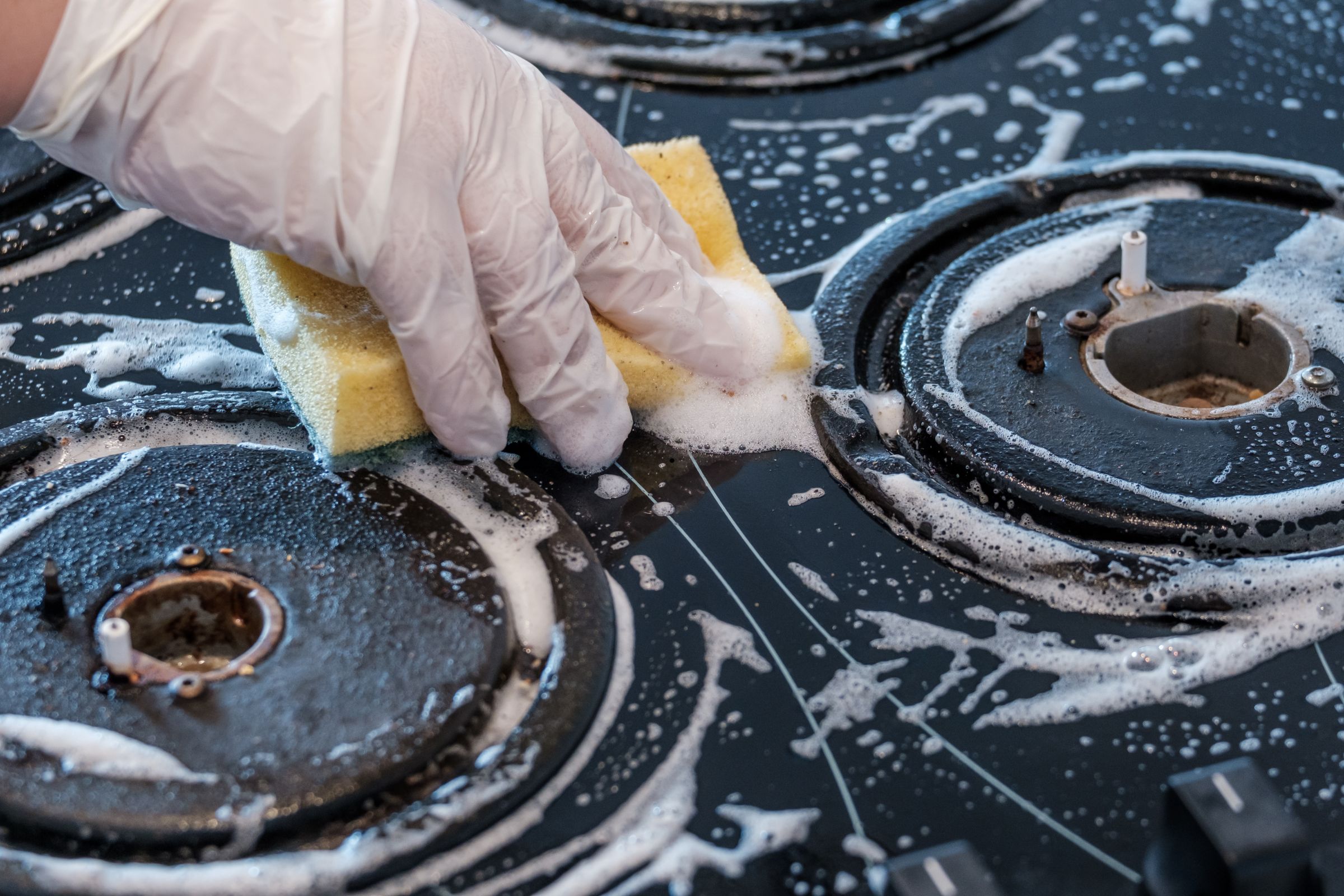
2 thoughts on “How to Clean Cast Iron Griddle on Gas Stove – Astonishing Hack!”